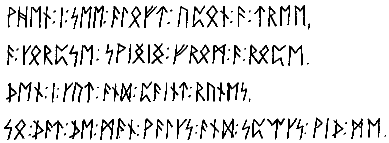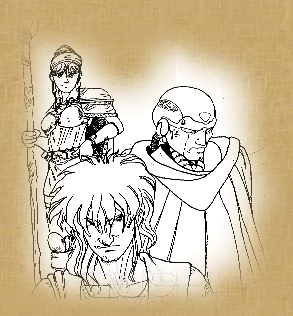
Runes have been found cut into stone as far back as 8000 - 2000 B.C. An old Norse poem of the Viking age called "Havamal" (utterance of the high one) says that runes have the power to bring the dead back to life.

When I see aloft upon a tree,
A corpse swinging from a rope.
Then I cut and paint runes
So that the man walks and speaks with me.
These written symbols are called runes, coming from the German word RAUNEN which means "To Whisper". Apparently this could imply speaking without speaking aloud. Runes were carved on pieces of wood, tombs, swords, armor and many other items.
Runes were believed to be magical. Nothing but pure magic could explain the phenomenon of speaking to someone without actually being there; and to think that the message inscribed could speak to thousands of people thousands of years after it's author had died. It was mystifying. It had to be pure magic!
People believed that when carved on a tomb, runes would keep evil forces away. Inscribed on a swedish gravestone appears "I hid here magic runes undisturbed by evil witchcraft, He who destroys this monument shall die in misery by magic art". Sometimes runes were carved on a tomb to keep the corpse from creeping from its grave. Such as "Sleep forever - Rest eternally - pain if you should rise".
In this same pattern, runes were engraved on armor and swords to make them more powerful in battle. Such is true of a sword named Marr. The inscription reads "May Marr spare nobody". To create a weapon of suffering, "Increase to pain" was the chosen script.

As long as the passion behind it was strong when the author wrote a rune, people believed that the presence of that word or phrase would serve as a guard, protector, servant, and in some cases, an assassin. It was also believed that the rune would maintain its magic even long after it's author had died.
Myths of the Norse tell of how man came upon the knowledge of the runes. Legend holds that Odin always sought knowledge. Desperate, He once even gave one of his eyes to Mimir The Wise so that he may drink from the well of wisdom.
To acquire the secret of the runes, he made the greatest sacrifice of all; his own life. Wounding himself with a spear, he hung by his feet from The World Tree (The Ash Yggdrasill) for nine days and nine nights where he neither ate nor drank. As the moment of death approached, the runes appeared to him. He screamed as he gathered them, then died. It has been said that Odin was resurrected by the other Gods so that he may share the secret of the runes.
I peered downwards,
I took up the runes,
Screaming I took them -
then I fell back.
He passed the hard won knowledge on to man so that they too were able to use the runes to protect themselves. Man became eager to exercise Odin's new found magic. In the past, people have carved and painted runes on their houses to protect them from evil. Midwives scratched them on the palms of the hands of women in childbirth to ensure safe delivery. Shamans used them to talk with the dead, to cast spells, and even reportedly, to fly.
Runes were carved in pebbles, on wood, ceramic tiles, chips of quartz crystal, bones, sea shells and written on paper. If written on paper, they would always be of a natural pigment, most likely - blood. Actually blood plays a big role in runes. Some legends say that in order for carved and etched runes to become magical they must have blood spread among and into them. Preferably the authors blood. Symbolically it would bond the rune with the passion of the mortal who carved it.
(The word divider was not used by all cultures)
As you may notice, the runes contain mostly vertical and angular lines. It was very rare for a rune to have a horizontal line within it. The reason for this is because the most available material to scribe upon was wood; and wood has a grain. A horizontal cut could split the wood and destroy the work. Over time, people eventually carved into other materials like stone and metal. The letters soon evolved to have horizontal lines and rounded edges.
You might also notice that some letters that exist in our English language do not exist in the runic alphabet. An example would be the runic letter "C". To write the word "coward", the "C" sound must be substituted with the runic phonetic alternative of "K" so that it's spelling would then read "Koward". In the case of spelling a word like "Celestial", the "C" would have to be substituted with the runic equivalent of "S". If you would like to avoid this confusion, you could use another form of the letter "K" such as "![]() " for the letter "C".
" for the letter "C".
Our english letter "Q" may be supplemented with the runic combination of "KW". Other alphabets in this book may need phonetic substitutions. Some scripts may not all have a sensible phonetic substitution, So you may need to create some letters to help some alphabets flow better.
The runic alphabet also has some new letters we have no one character for. The character "![]() " for "TH", "
" for "TH", "![]() " for "EA" and the runic letter "
" for "EA" and the runic letter "![]() " for the "NG" sound are perfect examples of this.
" for the "NG" sound are perfect examples of this.
For variety, I have added many additional alphabets from around the world. Some extinct and some still in use today. Though most of the rules of making magical inscriptions in this book are based upon cultures that used the runic alphabets, you may want to integrate them with these other alphabets to give your games more cultural depth.
When choosing an alphabet for your adventures, pick one that would correspond best with the race in which it would be associated with. The American braille alphabet could be used for a robotic race. Ugaritic would be good for barbaric tribes. A beautiful script like Sanskrit would be ideal for elves. Because of their constant work with stone, Ogham would work wonderfully with Dwarves and if you would happen to be running a space-fantasy game, Georgian or Glagolitic would be fitting. I suggest treating runic as common script in fantasy campaigns.
Use the arrows below to go to the next page

